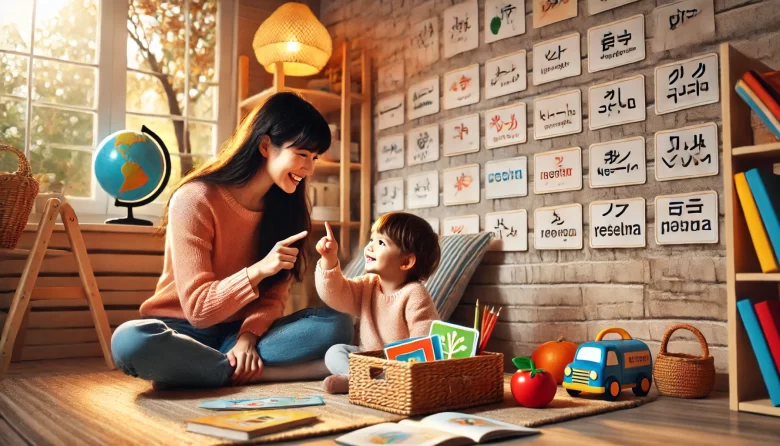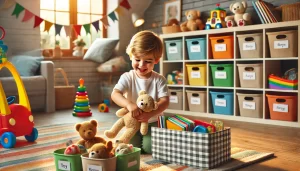Introducing a second language at an early age can provide lifelong benefits. Young children have a natural ability to absorb languages quickly, making early childhood an ideal time for bilingual learning. Whether you’re raising a bilingual child or simply want to introduce a new language, the key is to make learning fun, immersive, and part of daily life.
In this article, we’ll explore the benefits of early language learning, practical strategies for teaching a second language at home, and engaging activities to support bilingual development.
Why Teach a Second Language Early?
Children’s brains are highly adaptable in their early years, making language acquisition easier and more natural.
Key Benefits of Early Bilingualism:
✅ Enhances Cognitive Development – Bilingual children often have better problem-solving and multitasking skills.
✅ Improves Memory and Focus – Learning two languages strengthens brain function.
✅ Boosts Communication Skills – Expands vocabulary and enhances understanding of language structures.
✅ Increases Cultural Awareness – Helps children appreciate different cultures and perspectives.
✅ Provides Future Academic and Career Advantages – Knowing more than one language is a valuable skill.
🎯 Pro Tip: The earlier a child is exposed to a second language, the more naturally they will learn it—just like their first language.
Best Methods for Teaching a Second Language to Kids
Teaching a second language at home doesn’t require formal lessons. The key is to incorporate the language into everyday activities so learning happens naturally.
Create a Language-Rich Environment
Surrounding your child with the second language helps reinforce learning.
📚 Ways to Immerse Your Child in the Language:
✅ Label household objects in both languages.
✅ Play music, audiobooks, and nursery rhymes in the target language.
✅ Watch cartoons or educational shows in the second language.
🎯 Pro Tip: If possible, designate specific times of the day to speak only in the second language.
Use the “One Person, One Language” Method
This approach assigns one language to each parent or caregiver, helping children associate a specific person with each language.
👨 Example: A bilingual household where one parent speaks only English and the other only Spanish.
🎯 Pro Tip: Consistency is key—stick to your assigned language to help children distinguish between them.
Read Books in Both Languages
Reading in both languages helps children develop literacy skills and expand their vocabulary.
📖 How to Use Books for Language Learning:
✅ Choose bilingual books that show both languages side by side.
✅ Read the same story in both languages to reinforce understanding.
✅ Ask questions about the story in both languages.
🎯 Pro Tip: If your child is too young to read, let them listen to stories in the second language using audiobooks or read-aloud sessions.
Play Games and Do Hands-On Activities
Learning through play makes language acquisition more engaging and effective.
🎲 Fun Language Learning Games:
✅ Memory Matching Game – Match words with corresponding pictures.
✅ I Spy – Play “I Spy” using words from the second language.
✅ Scavenger Hunt – Find objects around the house while naming them in both languages.
🎯 Pro Tip: Make learning feel like playtime rather than a structured lesson!
Sing Songs and Listen to Music
Music helps with pronunciation, rhythm, and vocabulary retention.
🎶 Language-Boosting Music Activities:
✅ Sing simple nursery rhymes in the second language.
✅ Dance along to songs with repetitive lyrics.
✅ Play background music in the target language during daily routines.
🎯 Pro Tip: Children love repetition—sing their favorite songs multiple times to reinforce words and phrases!
Encourage Conversations and Role-Playing
The more a child speaks in the second language, the more confident they become.
💬 Ways to Encourage Conversation:
✅ Ask simple questions in the second language (e.g., “What color is this?”).
✅ Role-play daily scenarios like ordering food at a pretend restaurant.
✅ Have “puppet conversations” where puppets speak in the second language.
🎯 Pro Tip: Don’t worry if they mix languages at first—it’s a natural part of bilingual development.
Use Language Apps and Online Resources
Technology can be a great tool for language exposure when used effectively.
📱 Best Language Learning Apps for Kids:
✅ Duolingo Kids – Fun, interactive vocabulary games.
✅ Gus on the Go – Teaches basic words through storytelling.
✅ LingoKids – Engaging activities for young learners.
🎯 Pro Tip: Limit screen time and pair digital learning with real-life practice.
Fun Activities to Support Bilingual Learning
Cooking Together
🥕 Talk about ingredients and steps in the second language while cooking.
🎯 Benefit: Teaches food vocabulary and following instructions.
Storytelling with Picture Cards
📸 Use picture flashcards to tell a story in the second language.
🎯 Benefit: Enhances vocabulary and creativity.
Daily Routine Integration
🛏️ Use the second language for morning routines, meals, and bedtime.
🎯 Benefit: Reinforces language in real-life situations.
Talking with Native Speakers
👵 Encourage interactions with family members or friends who speak the language fluently.
🎯 Benefit: Improves pronunciation and conversational skills.
Overcoming Common Challenges
“My child refuses to speak the second language.”
✔️ Solution: Make learning fun through play, songs, and stories.
“I don’t speak the second language fluently.”
✔️ Solution: Learn alongside your child using books and apps.
“My child mixes both languages when speaking.”
✔️ Solution: This is normal! Over time, they will learn to separate the languages.
🎯 Pro Tip: Be patient—language learning is a gradual process!
Final Thoughts
Teaching a second language at home doesn’t have to feel like a lesson—it should be a natural and enjoyable experience. By integrating language learning into daily activities, using fun games, and creating an immersive environment, children will absorb new languages effortlessly.
The key is consistency, engagement, and patience. Every word, song, and story helps lay the foundation for bilingual success.




